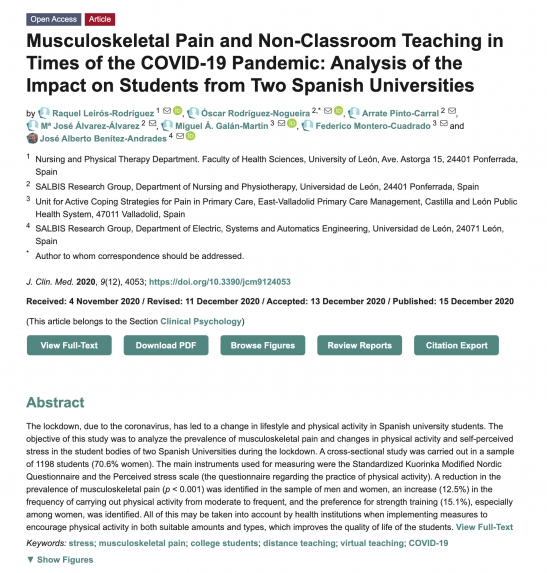Musculoskeletal Pain and Non-Classroom Teaching in Times of the COVID-19 Pandemic: Analysis of the Impact on Students from Two Spanish Universities
1 Nursing and Physical Therapy Department. Faculty of Health Sciences, University of León, Ave. Astorga 15, 24401 Ponferrada, Spain
2 SALBIS Research Group, Department of Nursing and Physiotherapy, Universidad de León, 24401 Ponferrada, Spain
3 Unit for Active Coping Strategies for Pain in Primary Care, East-Valladolid Primary Care Management, Castilla and León Public Health System, 47011 Valladolid, Spain
4 SALBIS Research Group, Department of Electric, Systems and Automatics Engineering, Universidad de León, 24071 León, Spain
* Author to whom correspondence should be addressed.
J. Clin. Med. 2020, 9(12), 4053; https://doi.org/10.3390/jcm9124053
Received: 4 November 2020 / Revised: 11 December 2020 / Accepted: 13 December 2020 / Published: 15 December 2020
(This article belongs to the Section Clinical Psychology)
The lockdown, due to the coronavirus, has led to a change in lifestyle and physical activity in Spanish university students. The objective of this study was to analyze the prevalence of musculoskeletal pain and changes in physical activity and self-perceived stress in the student bodies of two Spanish Universities during the lockdown. A cross-sectional study was carried out in a sample of 1198 students (70.6% women). The main instruments used for measuring were the Standardized Kuorinka Modified Nordic Questionnaire and the Perceived stress scale (the questionnaire regarding the practice of physical activity). A reduction in the prevalence of musculoskeletal pain (p < 0.001) was identified in the sample of men and women, an increase (12.5%) in the frequency of carrying out physical activity from moderate to frequent, and the preference for strength training (15.1%), especially among women, was identified. All of this may be taken into account by health institutions when implementing measures to encourage physical activity in both suitable amounts and types, which improves the quality of life of the students. View Full-Text

